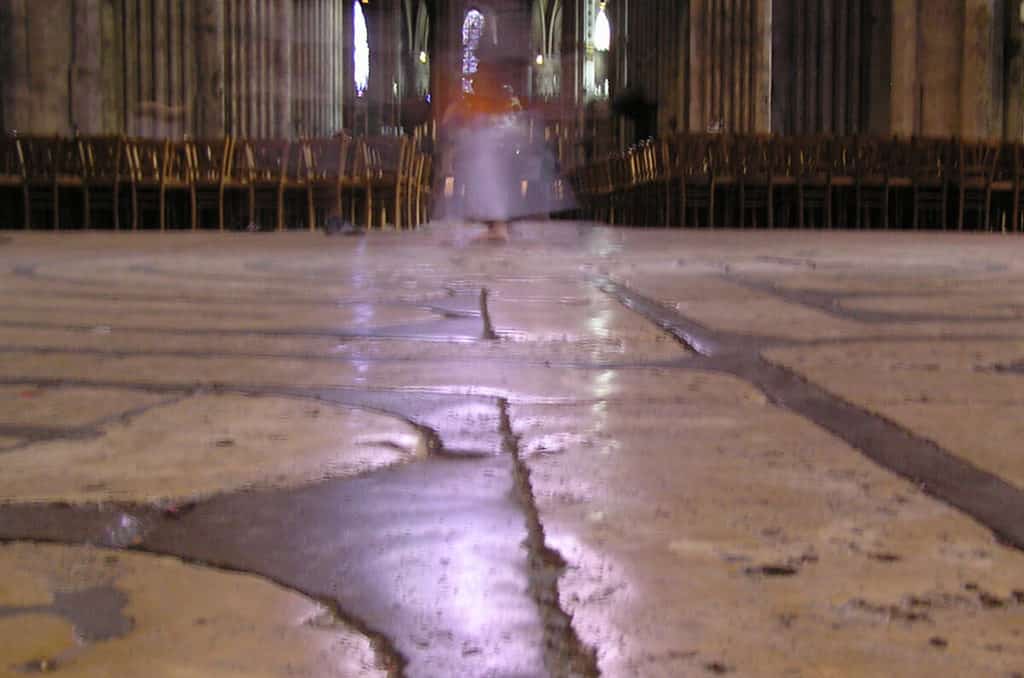The labyrinth of Chartres is one of the most famous labyrinths in the world. It is located in the Cathedral of Our Lady of Chartres in France and dates back to the 12th century. It represents the journey of life, with different twists and turns, but always heading to a fixed destination. For centuries, people have walked the labyrinth in search of clarity and direction.
Today, the history and original purpose of the labyrinth remain an enigmatic and intriguing mystery.
When was the labyrinth in Chartres Cathedral constructed?
When the labyrinth was constructed is not known for sure. The most sensible answer is, after the completion of the nave of the church.
Earlier is not logical because the labyrinth had to fit between the pillars. Moreover, it does not make sense to start a project of such a scale when it could still be damaged by the construction work. Historians today stick to the period between 1215 and 1220, but 1240 is also mentioned.
Why was the Labyrinth constructed?
The purpose of the labyrinth of Chartres is uncertain. Old documents tell us the labyrinth was used in the Middle Ages for a special liturgy in the Easter season. Under the sounds of the Victimae Pachali Laudes – a song about the resurrection of Christ – the dean (head of the priests) walked the labyrinth while holding a yellow yarn ball of wool against his body.
All the priests stood around the labyrinth. Then, from the center, the dean threw the wool at a priest, who held the wool string and threw the yarn ball back. Then it was thrown to the next priest, and so it went on.

The string is also a reference to the thread of Ariadne. In Greek mythology, the terrible Minotaur hid in the labyrinth. Eventually he was defeated by Theseus, a hero who had received a ball of wool from Ariadne so that he would not get lost.
For medieval man, this was the story of Christ (Theseus) who descended into hell (the labyrinth) and there defeated Satan (the minotaur), thus overcoming death and being able to return to the light.
What are the dimensions of Chartres labyrinth?
The labyrinth takes up the whole width of the central nave and has a diameter of about 13 meters (42,65 ft). The path is about 261 meters (856 ft) long.
272 stones were used for the lay-out. This number is equal to the days of human gestation (9 months). However, because some of the original stones have been damaged and replaced, the number may fluctuate slightly if you count the stones yourself.
Does the rose window perfectly overlay the labyrinth?
If you lay the western façade (the entrance) down flat, the Rose Window would twin perfectly with the labyrinth on the floor of the nave. This fact is quoted by many people, but, unfortunately, it is not quite true.
The idea was popularized by Keith Critchlow in the 70’s but there is a difference of about 3 meters (10 ft). The diameter of the rose window is about 1,5 meter (5ft) smaller than the diameter of the labyrinth.
(If you are interested in the geometry of Chartres Cathedral, you can still watch this documentary: Chartres Cathedral: A Sacred Geometry (2003)). The part about the labyrinth and the rose window below is shown in the fragment below.
What was at the center of the Labyrinth of Chartres?
We know from a description of the plaque from 1640 that the central slab depicted the battle between Theseus and the Minotaur. But now, the only thing left of the brass or copper plate that used to be in the middle of the labyrinth at Chartres Cathedral, are a few faded markings.
The original plaque was melted down in 1792 to make cannons for the army of the French Republic.
Excavations from 1849 brought to light that there was nothing buried under the plaque.
What the Chartres Labyrinth symbolizes
A labyrinth is the longest path you can walk to get from A to B. The concept is found in almost all cultures and therefore has a universal meaning. The labyrinth is the path of transformation, it is the way of your soul. But it also symbolizes your life path. It is the pilgrim’s journey, on his way to a fixed destination.

When can you walk the labyrinth of Chartres?
Typically, the cathedral nave is lined with chairs, obscuring the majority of the labyrinth.
The church has a long-standing custom of removing the seats and uncovering the labyrinth on the 21st of June, allowing it to be explored.
In recent years, cathedral officials have also implemented a program to uncover the labyrinth every Friday throughout the summer months, from the first Friday after Lent to the last Friday in October. However, this timetable is always subject to change, and special services, funerals, and cathedral events may result in the labyrinth remaining covered.
The best advice is to visit on a Friday during the summer and to arrive early, before the tour buses arrive, or else late in the afternoon, when the buses have left and the cathedral becomes less crowded.
Keep in mind, though, that the uncovered labyrinth is never guaranteed. If you visit and walk the labyrinth, please respect local customs and conduct yourself with dignity, as this is a Christian site of prayer.
How to walk the Labyrinth of Chartres?
Walking the labyrinth is a personal experience. On the internet, you will find a lot of suggestions about how you should or could walk the labyrinth. This is my advice, based on my own experience:
Meditate beforehand on an issue you are working on. As you walk the labyrinth, repeat the question until an answer presents itself to you. In the middle of the labyrinth, repeat the question and the answer you received in each leaf of the labyrinth. You will find that the answer becomes clearer and clearer. Then walk the labyrinth back while meditating on the answer.
Practical information
From the end of April to mid-October, you can see the Chartres en Lumiere every evening. The light festival starts at dusk, repeats until 1:00 am, and is great to experience. You can sit in the park at the main entrance.
- Plan your visit on Friday if you want to walk the labyrinth.
- The cathedral is closed for tourists on Sunday morning and during (other) church services.
- Opening hours are from 8.30 to 19.30
Audioguide: € 7,00 - Entrance Crypt (5 to 7 times a day): €4.00 (note: The tour is in French, you will receive a folder in your language)
- You can visit the bell tower for € 6,00
The official brochure of the cathedral can be downloaded HERE
More french information: http://www.chartres-cathedrale.fr/
Parking: Parking Cathédrale, Place Châtelet 28000, Chartres: €2,50 per hour
Opening hours and prices may vary.
Places to stay
Chartres Cathedral is magnificent, but you will also love the old town. Maybe you would like to book a hotel for a day (or two).
Just fill in the dates below and see what is available. I always use booking.com because it is easy to use, and it will always give you the lowest prices.
Maybe you’d like to check out the Mercure Chartres Cathedrale hotel. It is in the center, near the cathedral and has a lovely staff.








